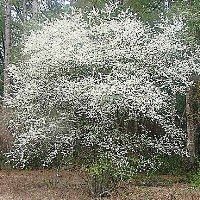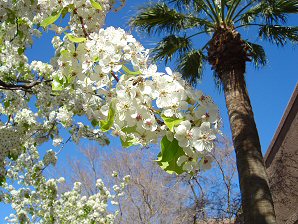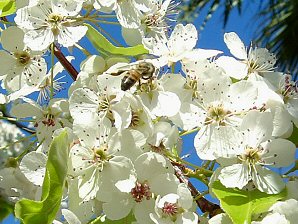Flowering American Plum.
Prunus americana, Family Rose ( Rosaceae ), Flowering American Plum. Also Called: Wild Plum, American Plum, Goose Plum.
We wish to thank Wikipedia, the free encyclopedia for some of the information on this page. We share images and information with Wikipedia.
The Flowering Plum is a small to medium sized tree. It has cultivated into several varieties for either its fruit or it flowers. It is a fast growing tree that is relatively small in height and diameter.
The tree is used as an ornamental in Arizona. The maximum height is about 27 feet. The wood of this tree is not used commercially.
The tree is planted throughout North America in moist, clay, loam, and sand. It is considered a native Arizona plant.
When this tree blooms, the citrus trees will bloom in about 30 days.
American plum grows at elevations up to 7,546 feet in Utah.
Here are some links to the Nature Hills Nursery; where you can order some of their very high quality Plum Trees. Some are flowering only. Others produce fruit. If you click, there is no obligation to buy! You will leave delange.org. NOTE: These are High Quality Speciality Trees. They are not usually found at the typical Big Box Stores!
| Princess Kay Plum - $139.90 A Puffy Cloud of Fragrant Spring Flowers Princess Kay Plum is a small, ornamental tree. Plant one in a prominent spot in your yard where you�re sure to enjoy its spring display. Your Princess Kay Plum was discovered in the wilds of northern Minnesota. It�s a small tree, but packs a large amount of appeal into its little frame. Even before the foliage appears in the spring, a profusion of double flowers, white and fluffy, appear amid the branches. They�re a sharp contrast against the black/brown bark of the trunk and branches that also feature large white lenticels (for an added and unique decorative appeal). As the flowers age, they take on a slight, pinkish hue providing a second wave of color. The blooms are also fragrant, a delightful treat as you take a spring walk through your yard and a lure to pollinators for your landscape. The foliage of your Princess Kay Plum is a medium green but sometimes develops a reddish-purple cast by fall to enhance your autumn lawn. Princess Kay Plum will grow to 15 feet in height with an equal spread. It has an upright form with an open, informal branching habit. Princess Kay is adaptable to a range of soil conditions, but you�ll want to choose a sunny spot for optimal performance. It tends to bloom when very young, so you won�t have to wait long for results. For an ornamental tree that doesn�t take much room or require a lot of care, Princess Kay Plum provides a lot of value. Why not grow your own white puffy cloud of fragrant flowers today! * Early spring blooms * Small ornamental tree * No messy fruit * Fragrant |
 | Chickasaw Plum - $89.90 Ornamental Shrub with Adorable Flowers and Fruit The Chickasaw Plum tree, Prunus angustifolia, is a deciduous multi-stemmed shrub or small tree which occurs in thickets, pastures, fields, fencerows, stream banks and disturbed areas. Chickasaw Plum trees are sometimes seen as a small short-trunked tree growing to 25' tall. Beautiful 5-petaled white flowers appear along the stems in March before the foliage emerges. The flowers are followed by small, cherry-like, edible, red to yellow plums which ripen in early to mid summer. Although the plums may be eaten raw, they are somewhat tart and acidic, and are perhaps best used in preserves and jellies. Native Americans regularly consumed the fruit fresh or dried it for winter. The sweet fruit is eaten by deer, bear, fox and raccoon. The toothed, narrow, bright green leaves (1-3 long) appear on branches and twigs that are an attractive reddish-brown and sometimes have thorny lateral branchlets. The flowering Chickasaw Plum is a true ornamental! * Multi-stemmed ornamental* Colorful fruit* White spring flowers* Fragrant* Drought tolerant* Wildlife interest* Adaptive to a variety of soils |
 | Plum Tree - Burbank - $179.90 Semi Dwarf Yellow Plum The Plum, Burbank, Prunus salicina, is a prize variety that was created by the master plant breeder himself, Luther Burbank over 100 years ago. Burbank is a natural semi-dwarf, reaching only 12'-35' with a graceful, irregular, spreading form in zones 5-9. It is super-sweet, purplish- redish mottled yellow in color, and has a deep yellow flesh with a very good flavor. This plum is semi-freestone, which means it partially separates from the pit. Burbank Plum requires minimal pruning which should be done after flowering when the tree is still leafless. It prefers a well drained, loamy, mildly acidic to mildly alkaline soil and does best in full sun. *Semi Dwarf*Yellow Flesh*Good Flavor |
 | Methley Plum Tree - $199.90 A Great Plum Tree for Beginners! The Methley Plum Tree, Prunus salicina 'Methley', is a fast growing tree that produces an abundant harvest of sweet, juicy fruit each year. Plant one in full to partial sun where its showy, spring display and abundant harvest won�t be overlooked. Methley Plum Tree will brighten up your spring yard with a flurry of stunning, snowy white blooms. Sweetly-scented, and delicate as a feather, the fragrant blossoms will drift through your yard on the gentlest of spring breezes By mid-July your Methley Plum Tree will be weighed down with medium to large fruit. The beauty of the deep reddish-purple skin is only surpassed by the gorgeous deep crimson color of the flesh. Methley plums are soft, sweet and very juicy. You�ll find them excellent for eating fresh or used in pies, jellies, jams, and preserves The Methley Plum is known for being a very heavy producer. Its yearly fruit is so abundant that you will need to harvest it multiple times each year. One of the best features of Methley is that, even though often laden down with fruit, it has very strong limbs so you won�t have to worry about propping it up or thinning it out like you do with some other high-producing trees. Methley Plum Trees will grow up to 20 feet in height with an equal spread. It has a medium growth rate and can adapt to a variety of soils. A self-fertile tree, Methley does not require another plum tree to produce fruit. Because only one tree is needed for large fruit harvests, it is perfect even for a smaller yard. If you�re looking for a plum tree that even a beginning gardener can be successful with, then Methley is for you. Its simplicity of care and hardy nature is often overlooked in light of its superior fruit qualities. However, Methley is a plum tree that truly has it all. * Delicious fruit * Self pollinating * Heavy bearer * Spring flowers * Strong limbs * Heat tolerant * Disease resistant * Adapts to a variety of soils |
Quick Notes:
Height: Up To About 25' - 30' Tall.
Flowers: The color of the spring flower bud is pink/rose changing to white as the flower opens fully. Composed of 5 petals, 1 inch across, long filaments, yellow anthers, appear in small clusters in early spring with the leaves.
Flowering Time: Mid February - March.
Leaves: Alternate, simple, broad leaf, 3 to 4 inches long, green above, and slightly paler beneath. Simple, ovate to elliptical, finely serrated margin, sharply pointed tip-margin with fine, double teeth, all teeth same size, not lobed, shorter stem, all side veins curve and are close to the same length. Leaf stalk less than 1/3 length of leaf. Deciduous leaves are green then Purple in the fall.
Trunk: Up To About 1 Foot Thick.
Bark: The Bark is dark brown, and the bark texture is furrowed.
Twig: Slender, reddish-brown some thorns, later developing an exfoliating gray film; buds reddish to gray and sharp pointed; leaf scars raised.
Fruit: The flowering Plum�s fruit is without husks or capsules, they are loosely packed, the fruit has a large pit. The fruit is larger than 3 cm and is blue and red at maturity. The fruit is very drupe and hang down very low off the twigs. Some varieties do not have fruit. They are very tasty.
Found: American plum is native to southeastern Canada and the conterminous states of the United States except Texas, Washington, Idaho, Oregon, Nevada, and California where it is planted and probably naturalized.
Hardiness:
USDA Zone 3a: to -39.9 �C (-40 �F)
USDA Zone 3b: to -37.2 �C (-35 �F)
USDA Zone 4a: to -34.4 �C (-30 �F)
USDA Zone 4b: to -31.6 �C (-25 �F)
USDA Zone 5a: to -28.8 �C (-20 �F)
USDA Zone 5b: to -26.1 �C (-15 �F)
USDA Zone 6a: to -23.3 �C (-10 �F)
USDA Zone 6b: to -20.5 �C (-5 �F)
USDA Zone 7a: to -17.7 �C (0 �F)
USDA Zone 7b: to -14.9 �C (5 �F)
USDA Zone 8a: to -12.2 �C (10 �F)
USDA Zone 8b: to -9.4 �C (15 �F)
USDA Zone 9a: to -6.6 �C (20 �F)
USDA Zone 9b: to -3.8 �C (25 �F)
USDA Zone 10a: to -1.1 �C (30 �F)
USDA Zone 10b: to 1.7 �C (35 �F)
USDA Zone 11: above 4.5 �C (40 �F)
Soil pH requirements:
5.6 to 6.0 (acidic)
6.1 to 6.5 (mildly acidic)
6.6 to 7.5 (neutral)
7.6 to 7.8 (mildly alkaline)
7.9 to 8.5 (alkaline)
Sun Exposure:
Full Sun
Elevation: Can be found from 0 - 7,546 Feet.
Habitat: Landscaping.Found throughout the United States. American plum is usually a woodland species, growing in mixed-hardwood communities and on woodland ecotones. It also grows in shrublands and sometimes, on open prairies. It often grows in riparian zones. Where it occurs on stream, pond, lake boarders, and on swamp ecotones.
Miscellaneous: Flowering Photos Taken February 12, 2004 In Glendale, Arizona.









